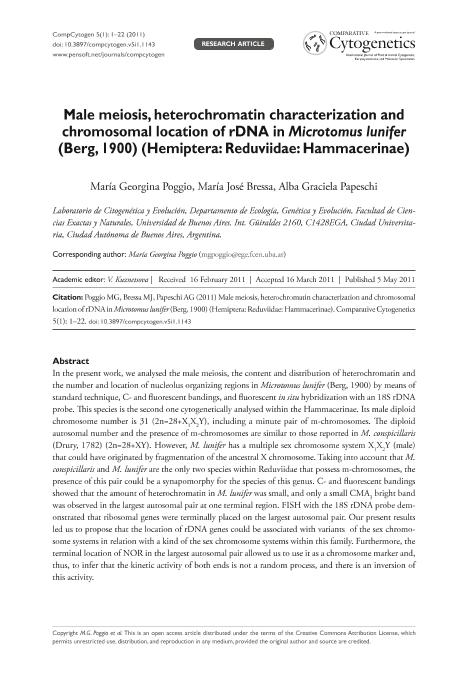Mostrar el registro sencillo del ítem
dc.contributor.author
Poggio, María Georgina

dc.contributor.author
Bressa, Maria Jose

dc.contributor.author
Papeschi, Alba Graciela

dc.date.available
2019-01-25T21:07:36Z
dc.date.issued
2011-05
dc.identifier.citation
Poggio, María Georgina; Bressa, Maria Jose; Papeschi, Alba Graciela; Male meiosis, heterochromatin characterization and chromosomal location of rDNA in Microtomus lunifer (Berg, 1900) (Hemiptera: Reduviidae: Hammacerinae); Pensoft Publishers; Comparative Cytogenetics; 5; 1; 5-2011; 1-22
dc.identifier.issn
1993-078X
dc.identifier.uri
http://hdl.handle.net/11336/68682
dc.description.abstract
In the present work, we analysed the male meiosis, the content and distribution of heterochromatin and the number and location of nucleolus organizing regions in Microtomus lunifer (Berg, 1900) by means of standard technique, C- and fluorescent bandings, and fluorescent in situ hybridization with an 18S rDNA probe. This species is the second one cytogenetically analysed within the Hammacerinae. Its male diploid chromosome number is 31 (2n=28+X 1X 2Y), including a minute pair of m-chromosomes. The diploid autosomal number and the presence of m-chromosomes are similar to those reported in M. conspicillaris (Drury, 1782) (2n=28+XY). However, M. lunifer has a multiple sex chromosome system X 1X 2Y (male) that could have originated by fragmentation of the ancestral X chromosome. Taking into account that M. conspicillaris and M. lunifer are the only two species within Reduviidae that possess m-chromosomes, the presence of this pair could be a synapomorphy for the species of this genus. C- and fluorescent bandings showed that the amount of heterochromatin in M. lunifer was small, and only a small CMA 3 bright band was observed in the largest autosomal pair at one terminal region. FISH with the 18S rDNA probe demonstrated that ribosomal genes were terminally placed on the largest autosomal pair. Our present results led us to propose that the location of rDNA genes could be associated with variants of the sex chromosome systems in relation with a kind of the sex chromosome systems within this family. Furthermore, the terminal location of NOR in the largest autosomal pair allowed us to use it as a chromosome marker and, thus, to infer that the kinetic activity of both ends is not a random process, and there is an inversion of this activity.
dc.format
application/pdf
dc.language.iso
eng
dc.publisher
Pensoft Publishers

dc.rights
info:eu-repo/semantics/openAccess
dc.rights.uri
https://creativecommons.org/licenses/by-nc-sa/2.5/ar/
dc.subject
Evolutionary Trends
dc.subject
Hammacerinae
dc.subject
Hemiptera
dc.subject
M-Chromosomes
dc.subject
Meiosis
dc.subject
Rdna-Fish
dc.subject
Reduviidae
dc.subject.classification
Otras Ciencias Biológicas

dc.subject.classification
Ciencias Biológicas

dc.subject.classification
CIENCIAS NATURALES Y EXACTAS

dc.title
Male meiosis, heterochromatin characterization and chromosomal location of rDNA in Microtomus lunifer (Berg, 1900) (Hemiptera: Reduviidae: Hammacerinae)
dc.type
info:eu-repo/semantics/article
dc.type
info:ar-repo/semantics/artículo
dc.type
info:eu-repo/semantics/publishedVersion
dc.date.updated
2019-01-25T13:36:44Z
dc.journal.volume
5
dc.journal.number
1
dc.journal.pagination
1-22
dc.journal.pais
Bulgaria

dc.journal.ciudad
Sofia
dc.description.fil
Fil: Poggio, María Georgina. Universidad de Buenos Aires. Facultad de Ciencias Exactas y Naturales. Departamento de Ecología, Genética y Evolución; Argentina. Consejo Nacional de Investigaciones Científicas y Técnicas; Argentina
dc.description.fil
Fil: Bressa, Maria Jose. Universidad de Buenos Aires. Facultad de Ciencias Exactas y Naturales. Departamento de Ecología, Genética y Evolución; Argentina. Consejo Nacional de Investigaciones Científicas y Técnicas; Argentina
dc.description.fil
Fil: Papeschi, Alba Graciela. Universidad de Buenos Aires. Facultad de Ciencias Exactas y Naturales. Departamento de Ecología, Genética y Evolución; Argentina. Consejo Nacional de Investigaciones Científicas y Técnicas; Argentina
dc.journal.title
Comparative Cytogenetics

dc.relation.alternativeid
info:eu-repo/semantics/altIdentifier/doi/http://dx.doi.org/10.3897/compcytogen.v5i1.1143
dc.relation.alternativeid
info:eu-repo/semantics/altIdentifier/url/https://compcytogen.pensoft.net/articles.php?id=1710
Archivos asociados
